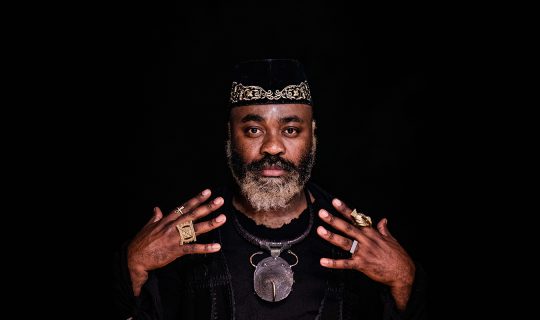January 28, 2016
Dr. Lonnie Smith not only stands as the preeminent Hammond B-3 organist in jazz today, but at the age of 73 he’s still progressing as an artist, as witnessed by his remarkable new album, appropriately titled Evolution. Teeming with his trademark accent marks, finesse caresses, bright sparks and jagged lines, Evolution finds Smith in the company of his regular band and special guests Robert Glasper on piano and Joe Lovano on saxophones. What’s even more notable is that the Doctor has returned to Blue Note Records for the first time in 46 years, bringing him home to the label where he made a name for himself in the late 1960s, first as a sideman with saxophonist Lou Donaldson, and soon after as a leader with his own soul-jazz classics such as Think! and Turning Point.
“It’s like those old western movies where the cowboys brand the cattle,” the amiable Smith jokes before switching into new similes. “Blue Note has always been in my blood. It’s like good wine that has lasted for all these years. When they called me, I was very pleased to be back in their company. After all, Blue Note and jazz is like Motown and soul. Imagine how a label like Blue Note stood the test of time and recorded all these great musicians. For it to still be here and for me to still be here, well, it’s an honor.”
A master of foot-tapping grooves, sophisticated harmonic voicings and indelible melodicism, Smith is the latest Blue Note legend from yesteryear to rejoin the classic label with vital new music, along with such titans as Wayne Shorter, Bobby Hutcherson and Charles Lloyd. Blue Note president Don Was signed Smith and produced Evolution, which is a robust and spirited collection of seven tunes, including fresh takes on Dr. Lonnie’s favorite originals and standards as well as brand-new excursions that he had never recorded before. Joining Smith is a top-notch band of musicians including tenor saxophonist/bass clarinetist/flautist John Ellis, trumpeters Maurice Brown and Keyon Harrold, guitarist Jonathan Kreisberg, and the powerhouse double drummer team of Joe Dyson and Johnathan Blake (appearing together on five of the seven numbers).
A native of Detroit where Smith has enjoyed a huge following, Was became reacquainted with his prowess at his appearance at the Monterey Jazz Festival in 2013, remarking that he was playing these “incredible, exciting grooves and he was totally rocking the place. He came back for an encore and started slapping his walking stick to create these insane, wah-wah polyrhythms. He was awesome—clearly in peak form and without peer.”
Born in Buffalo, NY in 1942, Smith was introduced to the Hammond organ as a teenager and began immersing himself in the records of Wild Bill Davis, Bill Doggett and Jimmy Smith as well as paying rapt attention to the church organ. Smith’s first gigs were at the Pine Grill, a Buffalo club where he came to the attention of Lou Donaldson, Jack McDuff and George Benson, eventually joining Benson’s quartet and moving to New York City.
After the stint with Benson, Smith released his debut album Finger Lickin’ Good for Columbia in 1967 before joining Donaldson’s band and making his first Blue Note appearance on the alto saxophonist’s hit 1967 album Alligator Boogaloo. Two more Donaldson dates followed (Mr. Shing-A-Ling and Midnight Creeper) before Smith was offered his own Blue Note deal, making his label debut with Think! in 1968. Smith went on to record another four Blue Note albums over the next two years including Turning Point, Move Your Hand, and Drives.
After his first run of Blue Note albums Smith recorded for many labels, most recently his own label Pilgrimage, and his wide-ranging musical tastes have found him covering everyone from John Coltrane to Jimi Hendrix to Beck. Earlier in 2015 when he was touring music from the new album in clubs, The New York Times caught his performance at the Jazz Standard and wrote that Smith “really seems to be up to something bigger than music, and older, and deeper. An hour and a quarter in his presence, and you start thinking about the nature of time, ancestors, the circulatory system. His tunes are relatively simple and his gigs are small-club casual, but they are done with so much care and attention that they seem to slow down the heart rate.”
The Doctor, in talking about his unique organ style, says, “It’s an extension of my being. It’s a part of my lens. It breathes for me; it speaks for me. I feel every bit of the organ. It’s like electricity—a fire that goes through my body. You can feel it vibrate. There’s nothing like it. It lifts me up, it crawls through the pores of the room.”
That was certainly the case when recording Evolution, which leads off with the catchy groove of “Play It Back,” a tune that Smith recorded in 1970 for the album Live at Club Mozambique, which Blue Note released later in 1995. Robert Glasper catches the groove on the acoustic piano while the double drums enlarge the beat and drive the tune and the organist zips into funky B-3 licks. “People keep asking me to play this song,” he says. “I had never played with Robert before, but it was wonderful. It really fit. We melded together.”
The slower, looser grooved “Afrodesia” comes from the 1975 album of the same name. On that session, a young tenor saxophonist named Joe Lovano made his auspicious recording debut. “Joe Lovano is an extraordinary player,” Smith says. “He still plays with that same feeling of joy as when he was young. He was already bad as a youngster and knew where he was heading. He did a great job playing a different horn [G Mezzo soprano saxophone], and he brings different colors into the song.”
The third tune is the ballad “For Heaven’s Sake,” which features Lovano on tenor. It opens with Kreisberg’s lyrical guitar then blooms with the three horns (Lovano, Ellis and Brown) harmonizing in an emotive vein. “I wrote that beautiful song a long, long, long time ago,” says Smith. “It’s about people taking me into oblivion. I remember when I was living in Hawaii, and I played this on a tape but never recorded it.”
Other originals showing up for the first time on a recording is the funky blues “Talk About This,” featuring ecstatic trumpeting from Brown and a band chant, and the haunting end song “African Suite” with Smith on Korg keyboard. Of the former Smith says that the tune is about “doing all the talking without saying something,” while the long-form finale is highlighted by the double drum bash and Ellis’s wafting flute melody.
The Doctor also delivers his reinventions of two classic standards, both in a guitar-drum trio setting. Thelonious Monk’s treasure “Straight No Chaser” gets taken for an uptempo ride. “It has a different flavor so we wouldn’t bore people,” he says. “It has to become yours at that moment. It’s like moving into a house that someone’s been living in, so you bring in your own furniture to make it yours. With Monk, you just hope you don’t destroy the beauty of what he was saying. We feel we achieved that.”
As for “My Favorite Things,” a favorite of Smith’s live set, the Doctor cooks up an orchestral swell on the Korg that opens into a bright guitar joyride. “I’m playing life itself,” he says. “It’s funny. Music is to be played. That means if a song comes up to you, the first thing you do is shake hands and then you feel the vibration of silence. You never know what’s going to happen, but it’s got to be soulful, which no one can teach you.”







